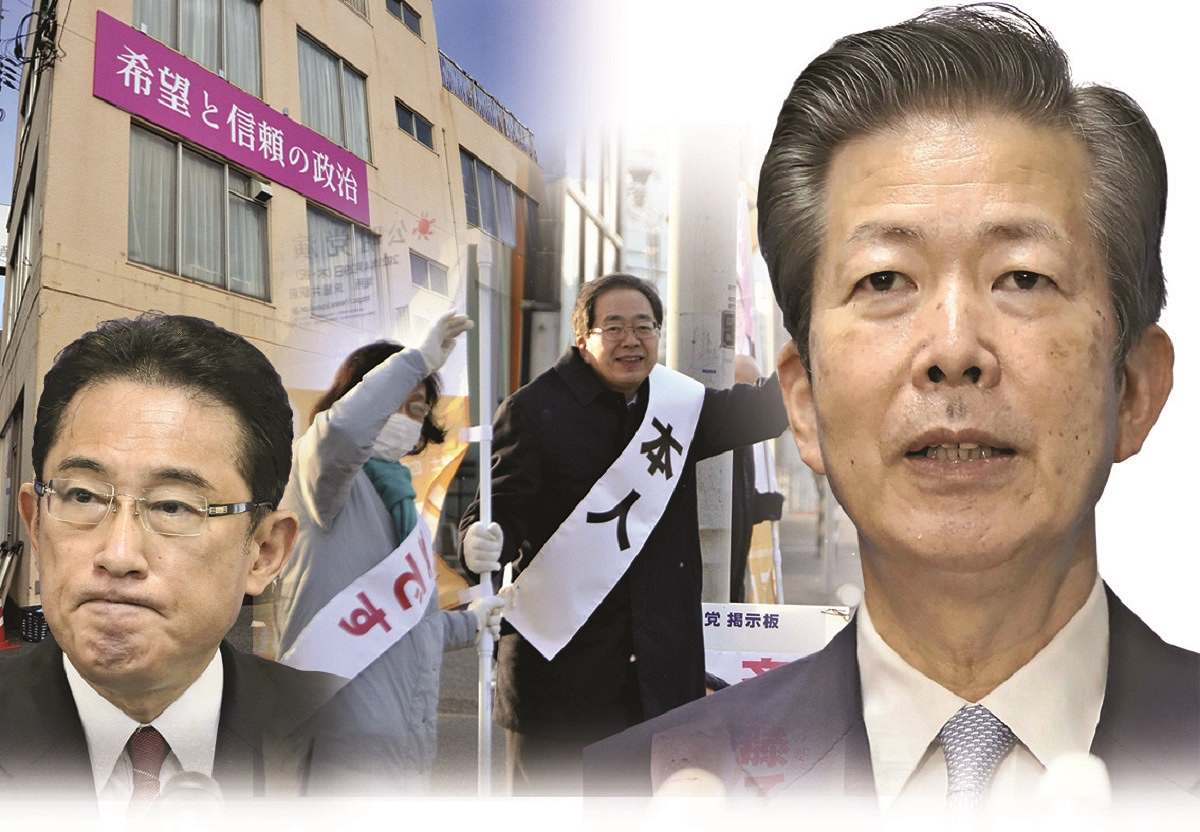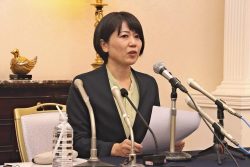Komeito’s Gamble of Fielding Candidate in Hiroshima No. 3 Constituency Rocks Coalition with LDP

13:12 JST, January 4, 2021
Tetsuo Saito, the deputy leader of Komeito, stood with his wife on a main road in Asakita Ward, Hiroshima, on the morning of Dec. 15, waving and saying, “Good morning” to passing drivers. Light snow was falling, and their breath was white in the air. A poster nearby, which appeared to have just been put up, read “the fulcrum of the coalition of the LDP and Komeito.”
On the same day, a signboard saying “Politics with Hope and Trust” was placed on the wall of a three-story building about 600 meters away from where Saito stood in the morning. On Dec. 20, Saito, who was elected to the House of Representatives under the proportional representation system from the Chugoku regional bloc, opened his campaign office in this building.
Announcing on Nov. 19 that he will run in the next election for the lower house from the Hiroshima No. 3 constituency, Saito has been preparing rapidly, trying to establish himself as the “unified candidate of the ruling coalition parties.”
The Hiroshima No. 3 constituency is where Katsuyuki Kawai, who resigned from the Liberal Democratic Party over a vote-buying scandal during the 2019 House of Councillors election, has his electoral base. Komeito is sensitive to the money-and-politics problem and has grown resentful, saying that for all the support Komeito has provided thus far, the party has been betrayed.
It has decided to endorse Saito, a leading figure in Komeito who has served as its secretary general and the chairman of its Policy Research Council, as its official candidate for the Hiroshima No. 3 constituency.
Meanwhile, the LDP’s Hiroshima prefectural chapter on Dec. 8 chose as Rintaro Ishibashi — a member of the Hiroshima Prefectural Assembly — as a successor to Kawai. These moves have brought about an unusual situation in which the LDP and Komeito, which form the ruling coalition, are at loggerheads with each other, with overtones of a possible breakup.
Another factor behind Komeito’s insistence on having Saito run for the single-seat constituency is the fact that members of Soka Gakkai, the lay religious organization which supports Komeito, have advanced in age, resulting in a decline in the party’s vote-getting power.
Komeito gained a total of only 6.97 million votes in proportional representation blocs in the previous lower house election in 2017, falling short of 7 million for the first time since the party formed its coalition with the LDP in 1999. Komeito has retained two seats in the Chugoku regional bloc — which includes Hiroshima — under the proportional representation system, with 11 seats contested.
But the part secured its second seat in the previous race with the lowest number of winning votes. A sense of crisis runs strong within Komeito. A senior party official said, “If the number of votes we can collect declines further, it will be difficult for the party to secure two seats in the bloc.”
The party is now attempting to jack up the votes it can get in the proportional representation bloc by fielding a candidate in a single-seat constituency.
To deal with the present situation where the LDP and Komeito are at loggerheads, LDP Secretary General Toshihiro Nikai said, “We want to coordinate views amicably with Komeito while rspecting the intentions of our prefectural chapter,” indicating his party’s desire to find a compromise.
Within the LDP, there has emerged an idea of supporting Saito in the single-seat constituency, while having Ishibashi run in the regional bloc under the proportional representation system. For Saito, who has little chance of winning in the single-seat constituency with only the votes of Komeito supporters, which is said to total only 20,000 votes per single-seat constituency, it will be indispensable to win cooperation from the LDP.
Komeito is calculating that it would be relatively easy for its request to be met if it is made to Prime Minister Yoshihide Suga — the LDP president — or to Nikai. Komeito is said to have had strong connections with both for a long time.
When Komeito leader Natsuo Yamaguchi reported to Suga that his party had just endorsed Saito for the Hiroshima No. 3 constituency, Suga listened to what Yamaguchi said, nodding his head without objecting.
Behind the scenes, however, Komeito has compiled a list of members of the LDP’s Kishida faction across the country and pressured them through phone calls and other means, saying that unless the faction concedes the Hiroshima No. 3 constituency, Komeito won’t support Kishida faction members in the election.
Hiroshima is the electoral power base for Fumio Kishida and a stronghold of the Kishida faction, which he leads. Six of the faction’s members in the upper and lower houses were elected from the prefecture.
By directing the brunt of its criticism primarily at the Kishida faction, Komeito is apparently trying to have the LDP give up fielding its candidate in the constituency.
“You should stop extending support to the [lower house] members of the Kishida faction.” On Nov. 27, an instruction from the Komeito headquarters was given to its prefectural chapter in Ibaraki, a prefecture far away from Hiroshima. In the Ibaraki constituency, there are two lower house members of the Kishida faction.
A senior official of the local chapter of Komeito did not attempt to hide his surprise, saying, “The situation in Hiroshima has made its way as far up as Ibaraki.”
Kishida showed his irritation to those around him, saying, “I can’t understand this.” But as some Diet members’ prospect of winning their seat is dim without the votes of Komeito supporters, he also revealed his mixed feelings that “things are not so easy that we could expect to win the race even if the ruling coalition was broken up.”
If the coordination of views between the two parties over the issue of the Hiroshima No. 3 constituency runs into trouble, it may affect the cooperation between the two parties in other electoral districts. Komeito has already decided to endorse other candidates for nine constituencies across the country.
The Kanagawa No. 6 constituency, the only constituency where Komeito failed to win a seat in the previous lower house election, is one of the districts that the party prioritizes supporting. Komeito’s Kiyohiko Toyama, who was elected from the Kyushu bloc under the proportional representation system in the previous race, has been endorsed to run in this single-seat constituency.
“I believe firmly that the politician who will shoulder the burden of serving in the ruling coalition of the LDP and Komeito in the future is Diet member Mr. Toyama.” As this video message from Suga was shared at a gathering held for Toyama at a hall in Yokohama on the evening of Nov. 27, the hall became charged with an air of unusual excitement.
Suga has his electoral power base in Yokohama, and his full support brought about 1,700 people, including members of business organizations that support the LDP, to the meeting. An official related to Komeito proudly said, “We were able to display the solidarity of the LDP and Komeito.” Yet, when asked for a comment about the Hiroshima No. 3 constituency, he said with a gloomy look, “If the conflict drags on, it will affect our election partnership across the country.”
A sense of discontent is spreading within the LDP against the latest move made by Komeito, with people feeling it has gone too far. An LDP member who once served as a Cabinet minister blustered, “If Komeito thinks that way, we would not mind dissolving our coalition.”
The move made by Komeito, ready for the possibility of causing a rift between the LDP and itself, is a risky gamble that may even decide the fate of the coalition.
■ ‘Fusion of the LDP, Komeito’
Since the LDP and Komeito launched a coalition government in 1999, they have deepened their election partnership under a barter system in the lower house election. Komeito has its supporters vote for the LDP candidate in single-seat constituencies, while the LDP has its supporters vote for the Komeito candidate in proportional representation blocs.
In the 2000 lower house race, current Komeito leader Yamaguchi ran for the Tokyo No. 17 constituency but was defeated by the LDP’s Katsuei Hirasawa, now the reconstruction minister. But since the lower house election in 2003, the two parties have ended their rivalry in the single-seat constituencies.
Komeito has the advantage of the organizing ability of Soka Gakkai, the party’s support organization. During the 2017 lower house election, 266 LDP candidates ran for a single-seat constituency and were backed by Komeito, accounting for 96 percent of all LDP candidates.
Some have noted that the LDP candidates’ vote-collecting power has declined, as their dependency on Komeito’s organized votes has become the norm. On the other hand, it would be difficult for Komeito, which has fielded candidates in nine single-seat constituencies, to win a lower house seat without support from the LDP.
Some political pundits call this mutually dependent relationship, which neither side can get out of, the “fusion of the LDP and Komeito.”
"Politics" POPULAR ARTICLE
-

Japan to Support Central Asian Logistics Route That Bypasses Russia, Plan to Be Part of Upcoming Summit in Tokyo
-

Japan to Tighten Screening of Foreigners’ Residential Status by Providing Information of Nonpayment of Taxes
-

Takaichi Cabinet Approval Holds at 72% as Voters Back Aggressive Fiscal Stimulus, Child Benefits
-

Chinese, Russian Bombers Flew Unusual Path by Heading Toward Tokyo; Move Likely Meant to Intimidate Japan
-

Takaichi Meets Many World Leaders at G20 Debut in Johannesburg; Speaks with Heads of Countries Including Italy, U.K., Germany, India
JN ACCESS RANKING
-

Keidanren Chairman Yoshinobu Tsutsui Visits Kashiwazaki-Kariwa Nuclear Power Plant; Inspects New Emergency Safety System
-

Imports of Rare Earths from China Facing Delays, May Be Caused by Deterioration of Japan-China Relations
-

University of Tokyo Professor Discusses Japanese Economic Security in Interview Ahead of Forum
-

Japan Pulls out of Vietnam Nuclear Project, Complicating Hanoi’s Power Plans
-

Govt Aims to Expand NISA Program Lineup, Abolish Age Restriction






















